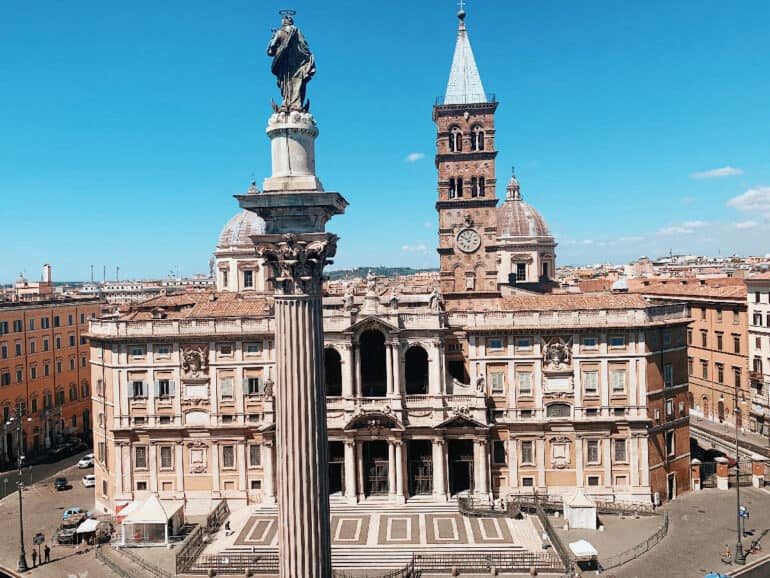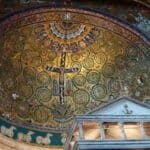Discover all the secrets and the masterpieces of one of the four major Basilicas in Rome
Its legendary origins, the snow miracle, the gold coming from the New World, the mosaics, the grave of a very famous character: all these elements make the Basilica of Santa Maria Maggiore (Basilica of St. Mary Major), an authentic treasure chest of wonders in the heart of the eternal city.
The Basilica and the snow miracle
During the night of the 4th of August in 358 a roman noble, senator called Giovanni, had a dream about Virgin Mary. She told him to build a church dedicated to her on the Esquilino Hill, exactly on the spot where it will snow the next morning. The same night Virgin Mary also appeared in a dream to Pope Liberio, bringing him the same message. And, according to the legend, the following morning it snowed for real! Giovanni and the Pope arrived on the spot where Liberio drew the perimeter of the future Basilica of Santa Maria Maggiore on the ground, initially dedicated to Saint Mary of the snow, but also known as Basilica Liberiana.
This is what the legend says. But in reality, things went differently and the Basilica was erected, one century later (starting from year 432), on the spot where another church was erected by Pope Sisto III.
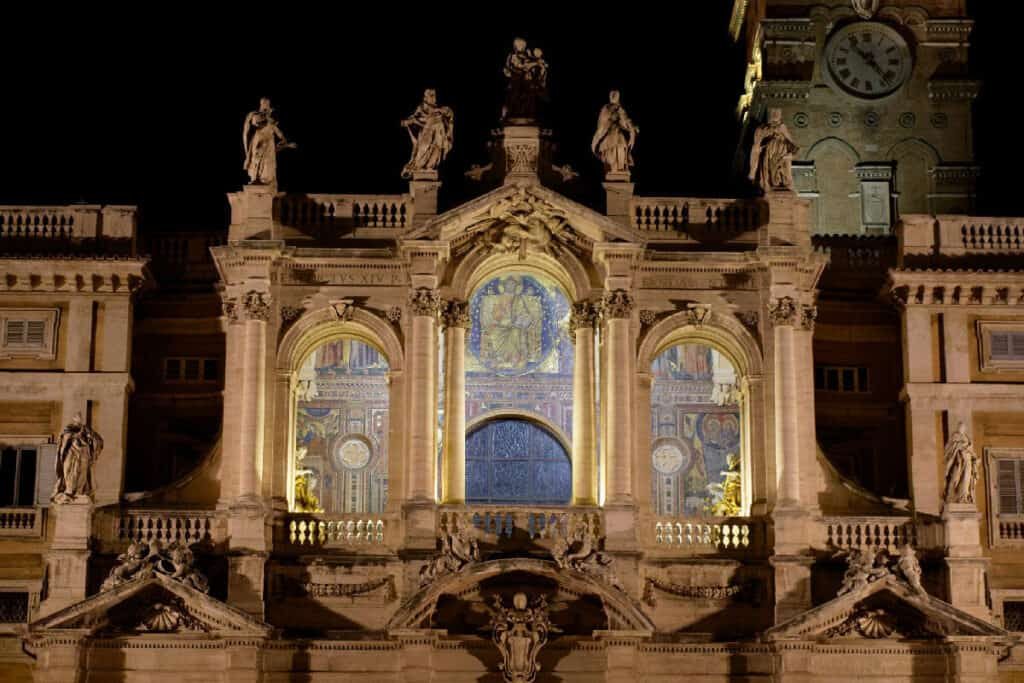
The main facade with the porch and the loggia for the blessings, re-built by Ferdinando Fuga in the middle of XVIII century, invite you to enter, silently, in this chestnut of beauty and fascination.
Once inside you will immediately realize that Santa Maria Maggiore is the only one, among the 4 Patriarchal Basilicas in Rome to have kept the original paleochristian structure, with some changes. A structure of three naves punctuated by 42 columns, enriched by the fourteenth century transept and the new apse. In the XVI and XVII centuries the Sistine Chapel and the Paolina Chapel were added. The Chapel Sforza was erected instead following the project of Michelangelo Buonarroti.

The tallest bell tower in Rome
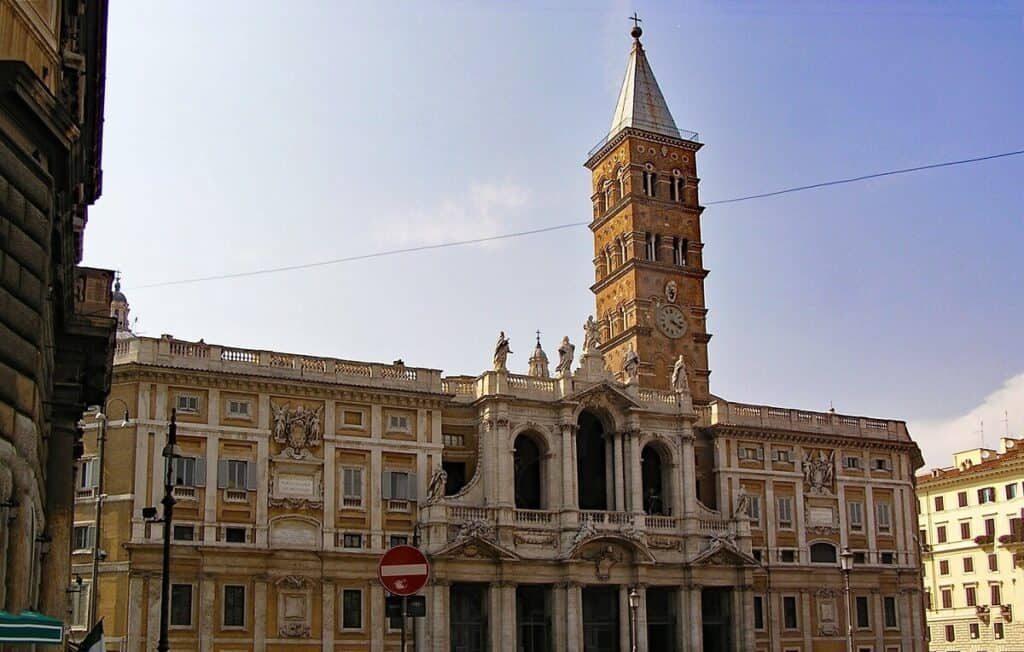
The Romanic bell tower of the Basilica stands on the Esquilino Hill with 75 meters of height, the tallest in Rome. It was built by Pope Gregorio XI after his return to Rome from Avignone, and it hosts 5 bells. One of these is called “la Sperduta” (the lost), and its unmistakable sound calls the faithful every evening. The name of this bell refers to a legend from XVI century. Legend says that a young shepherdess, probably blind, while tending her flock, got lost in the grasses that surrounded the Esquilino Hill in ancient times. When the evening came, the sound of the bells of Santa Maria Maggiore should have led her home. Instead, the shepherdess disappeared. That’s the reason of the evening ritual of “La sperduta”.
Entering inside the porch, on the right, you will be greeted by the statue of Filippo IV from Spain, benefactor of the Basilica. The sketch of the work, made by Girolamo Lucenti in the XIII century, was drawn by Gian Lorenzo Bernini.
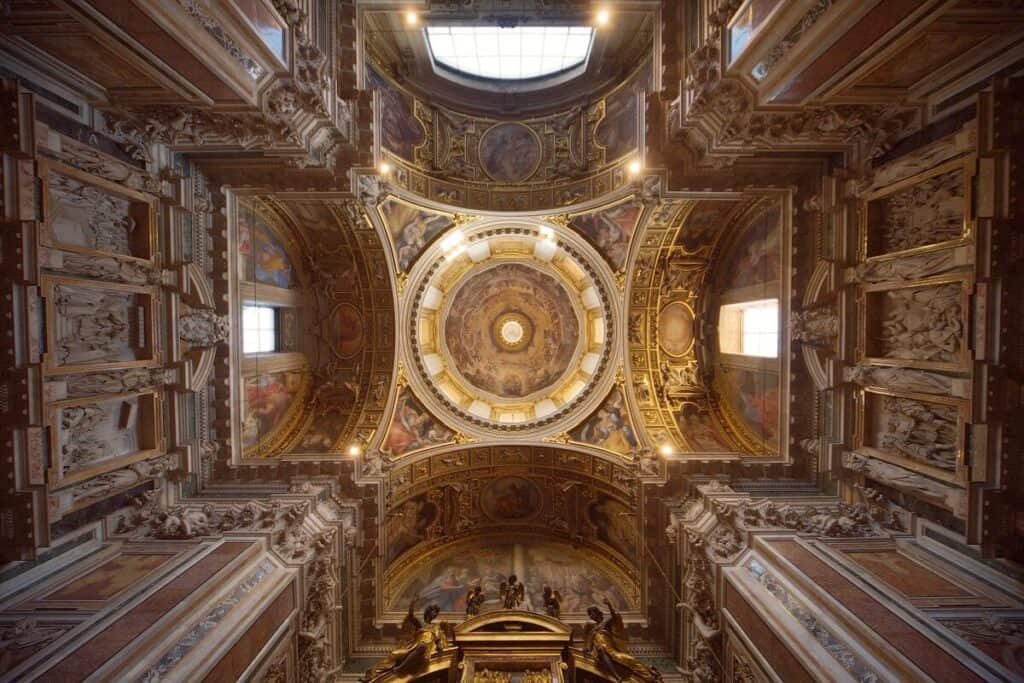
In the middle, the great bronze door, made by Ludovico Pogliaghi in 1949, depicts episodes of Virgin Mary’s life. On the left stands the Porta Santa (Holy Door), blessed by Giovanni Paolo II on the 8th of December 2001, completed by the sculptor Luigi Mattei that was offered to the basilic by the Equestrian Order of the Holy Sepulchre of Jerusalem.
Entering the basilica, the visitor will be charmed by the great Royalty mosaic on the apse where Virgin Mary and the so called Theotokos, appears on the heavenly throne, while Christ crowns her as Queen of Heaven.
A temple where classical antiquity, Christianity and modernity meet
Santa Maria Maggiore is infact one of the few Christian monuments where the coexistence of classical antiquity, Christianity and modernity, is notice. The uniqueness of the Basilica is due to the beautiful mosaics dated back to V century, wanted by Sixtus III, running along the central nave and on the triumphal arch. The refined decorations of the Thriumphal Arch show the stories of the Bible and of Jesus’ childhood.
A particular episode from Apocryphal Gospels, depicted only in Santa Maria Maggiore, shows Jesus, during the Flight into Egypt, arriving in the city of Sotine, together with his parents, while the pagan idols falling on the floor and a character called Afrodisio greets baby Jesus as the Redeemer.
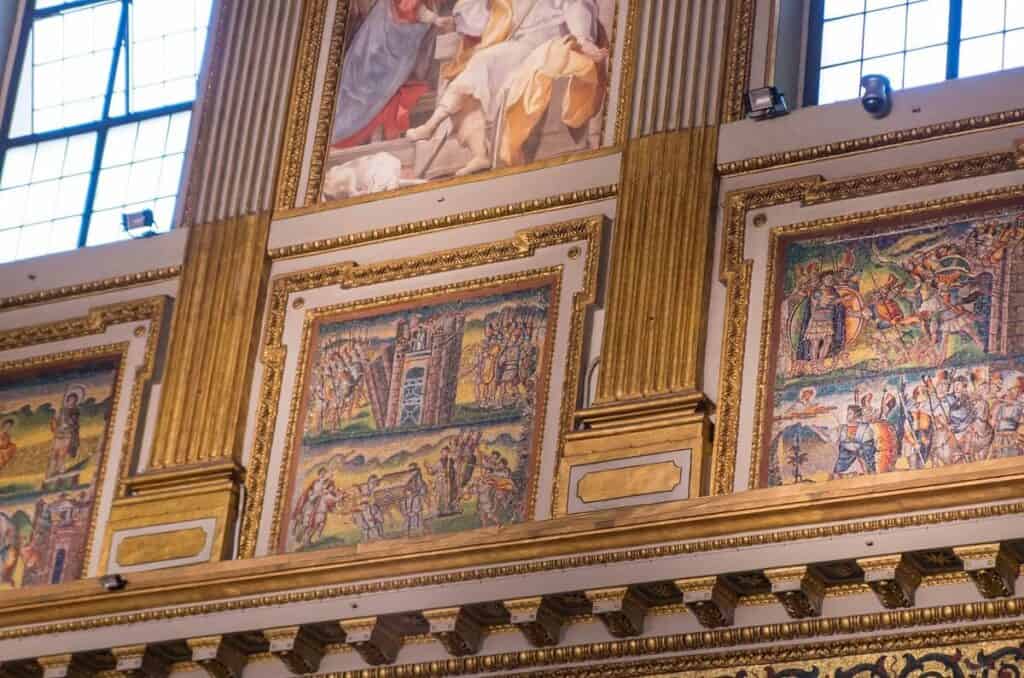
On the occasion of the Jubilee in 1300 the basilica went under renovation. During the Pontificate of Niccolò IV the transept was added and a new apse was created, decorated with mosaics created by Jacopo Torriti, that depicted Stories of Mary and her coronation of Mary, dated back to 1295. It is the first representation of Virgin Mary’s coronation on an apse.
The mosaics of the central nave summarize four cycles of Sacred History that sees protagonists Abraham, Jacob, Moses and Joshua together to witness God promising Jewish people land and help to reach it.essa di Dio al popolo ebraico di una terra e il suo aiuto per raggiungerla.
Another incredible detail of this amazing building is the floor from the XIII century made by the marble masters belonging to the Cosma family (this kind of floor is infact called cosmatesco); the floor looks similar to a refined carpet offered to Eugenio III from the noble roman Scoto Paparoni and his son Giovanni in the XII century.
The monumental effect of the spaces, the splendor of the marbles, and the richness of the decoration is astonishing.
The canopy above the main altar, in front stands the Confessione, wanted by Pio IX and realized by Vespignani, where the Cradle reliquary is preserved, was made by Ferdinando Fuga. The crystal reliquary, shaped as a cradle, keeps the wooden pieces that belonged to the manger where Baby Jesus was laid and that were brought to Rome from the Holy Land by many pilgrims, according to the legend.
The New World’s gold
Just look up to admire the only fifteenth century ceiling left in Rome, wanted by Alexander VI Borgia: a carpet in pure gold that takes your breath away.
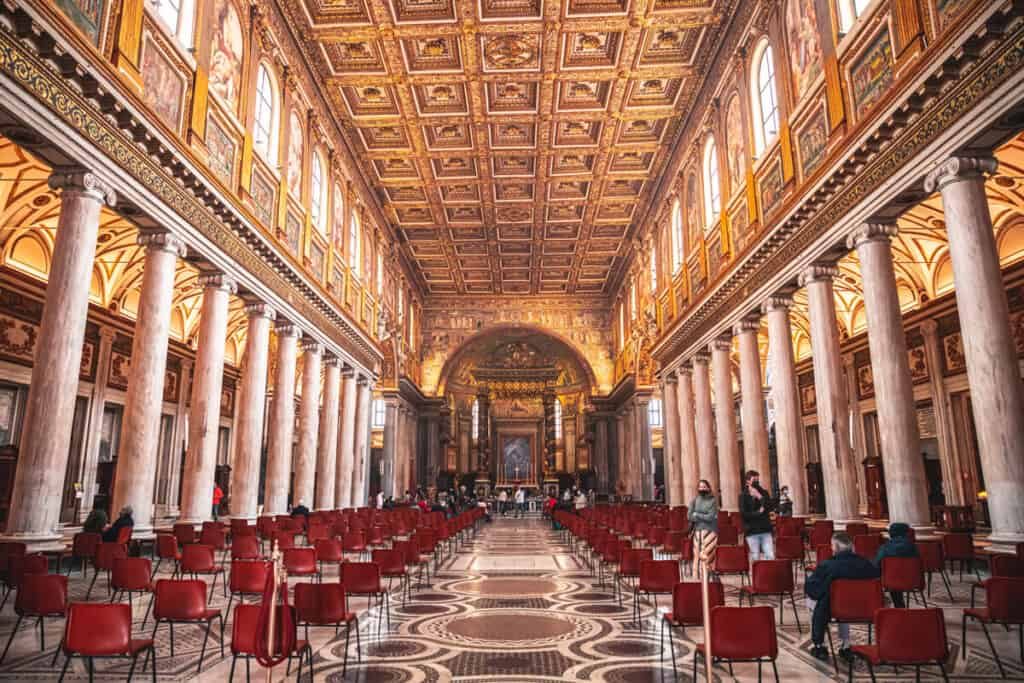
The gold that covers the coffered ceiling, designed by Giuliano da Sangallo and completed by his brother Antonio, with the heraldic coat of arms of the Pope in the center, is not a normal kind of gold. Again, history is intertwined with the myth, because the coverage of the ceiling was made using the first gold load coming to Rome from America: a testimony of the stunning discovery of the New World. An incredible gift to Pope Alessandro VI from the Catholic King and Queen of Spain, Isabella and Ferdinando.
The grave of Gian Lorenzo Bernini
“Noble Bernini family waits here for Resurrection“. This is what is written on Gian Lorenzo Bernini’s tombstone, beside the main altar; the simplicity of the message is touching.
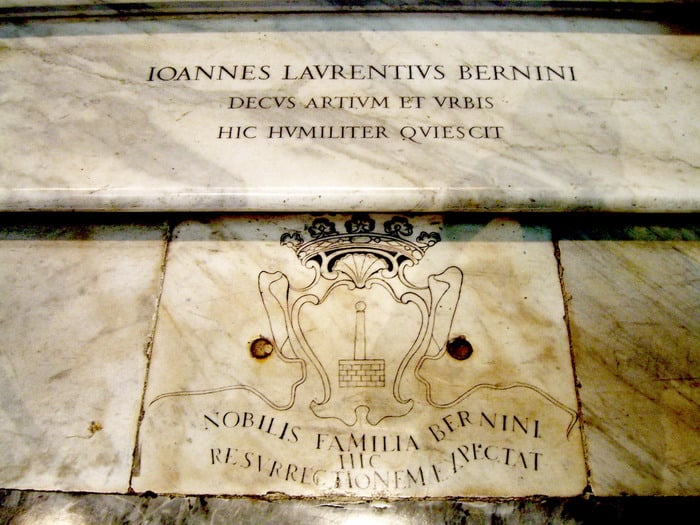
The Baths underneath the Basilica
Between 1966 and 1971, because of humidity problems, an excavations campaign under the floor of the basilica was needed, lead only along the side naves. Taking away the ground which filled many environments, dating back II and III century, came to the light. They have been now musealized, and you can see them from the basilica museum.
The bath complex, presumably private, consisted of several different environments articulated, at various levels, around a large courtyard. The path contains traces of a small bath, with mosaics and cavities for heating, ancient tiles, traces of decorative geometric frescoes and others related to an agricultural calendar, and remains of an opus sectile floor presumably pertaining to the bath plant.

Piazza di Santa Maria Maggiore (Monti/Esquilino)
Open daily from 7am to 6.45pm


